A Cobalt Parrotlet may be tiny, but its personality is anything but small. These intelligent and energetic birds thrive on interaction, making training an essential part of their care. Without proper guidance, a Cobalt Parrotlet can develop unwanted behaviors like biting, excessive vocalization, or fearfulness. However, with the right training approach, you can build a strong bond, encourage positive behavior, and create a happy and well-adjusted pet.
Many owners struggle with challenges such as taming, teaching basic commands, and preventing aggression. Training isn’t just about setting rules—it’s about creating a trusting relationship where your bird feels safe, engaged, and eager to learn. The right techniques can help your Cobalt Parrotlet develop confidence, respond to your cues, and even enjoy activities like step-up training and playtime.
In this guide, I’ll share five powerful training secrets to help you understand and connect with your Cobalt Parrotlet. These tips will cover hand-taming, teaching essential commands, preventing biting, setting up the perfect cage environment, and providing the best diet for a well-behaved and healthy bird. Let’s dive in!
The Key to Bonding: Hand-Taming Your Cobalt Parrotlet
Why Early Hand-Taming is Essential for Trust-Building
Early hand-taming plays a crucial role in building a trusting and affectionate relationship with your parrotlet. Without proper handling, this tiny yet strong-willed bird may become fearful, defensive, or even aggressive. The sooner you begin taming, the easier it becomes to establish trust and encourage friendly interactions.
Wild instincts make these birds naturally cautious of hands, so daily handling helps them feel comfortable and safe. When they associate hands with positive experiences like treats and gentle attention, they learn to enjoy human interaction. Hand-taming also lays the foundation for essential commands, such as step-up training and recall. A well-socialized bird will be more engaging, less likely to bite, and more eager to participate in training sessions.
Step-by-Step Guide to Hand-Taming
Create a Calm Environment
Parrotlets respond best in a quiet, low-stress space. Keep the cage in a peaceful area and speak softly to help them feel at ease. Avoid sudden movements that could startle your pet.
Let Your Bird Adjust to Your Presence
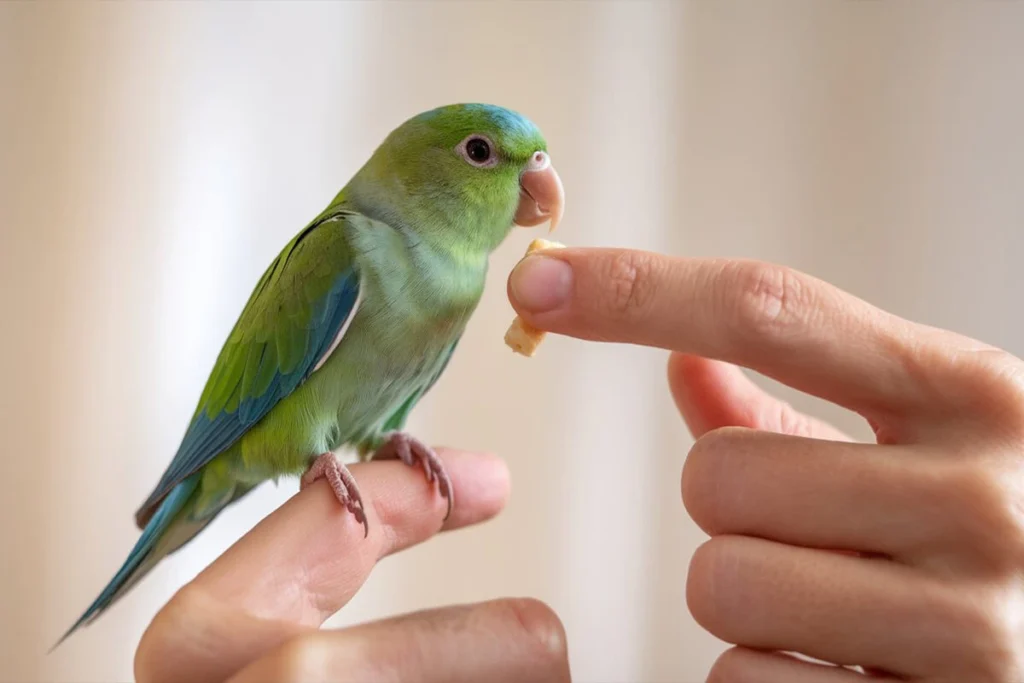
Before attempting to touch your pet, spend time near the cage. Talk gently and offer treats through the bars to create positive associations with your presence. This step builds initial trust.
Introduce Your Hand Slowly
Open the cage door and rest your hand nearby without forcing interaction. Allow the bird to observe and approach at its own pace. If it seems hesitant, keep your hand still and let it adjust gradually.
Use Treats to Encourage Interaction
Hold a small treat, like millet or a tiny piece of fruit, between your fingers. Let your pet come forward to take it without making sudden movements. Repeating this step teaches the bird that your hand brings positive rewards.
Encourage Step-Up Training
Once your bird feels comfortable, gently press your finger against its lower chest while offering a verbal cue like “Step up.” Reward each successful attempt with praise and a treat.
Practice Daily for Consistency
Short, frequent training sessions work best. Spend 5-10 minutes a few times a day reinforcing hand-taming exercises. The more consistent you are, the faster your pet will trust you.
Using Positive Reinforcement with Treats and Clicker Training
Parrotlets respond well to positive reinforcement, learning faster when good behavior is rewarded with treats, praise, and a training clicker.
- Clicker Training Benefits: A clicker provides a clear, consistent sound that signals success. Your pet quickly associates the click with rewards, reinforcing behaviors like stepping up or staying calm in your hand.
- Best Treats for Training: Use small, irresistible treats such as millet spray, diced fruits, or specially formulated bird treats. The right reward motivates engagement and positive responses.
- Timing is Key: Click and reward immediately after your pet performs the desired action. Delayed rewards can cause confusion and slow progress.
Avoiding Common Mistakes That Lead to Fear or Biting
Even with the best intentions, some handling mistakes can cause setbacks in training. Avoid these common errors to ensure smooth progress:
- Forcing Interaction: Never grab or chase your bird to make it step up. This creates fear and resistance instead of trust.
- Ignoring Body Language: If your pet fluffs up, backs away, or nips at your hand, respect its signals. Pushing forward when it feels uncomfortable can lead to defensive biting.
- Training in a Distracting Environment: Loud noises, sudden movements, or unfamiliar surroundings can create anxiety. Choose a quiet, familiar place for training.
- Skipping Consistency: Infrequent training confuses your pet and slows progress. Daily handling, even for a few minutes, helps reinforce trust and comfort with human interaction.
By following these steps and avoiding common mistakes, you can build a trusting, affectionate relationship with your feathered companion. Hand-taming sets the stage for a well-behaved and happy pet that enjoys spending time with you.
Teaching Your Cobalt Parrotlet to Step Up and Follow Commands
Importance of Teaching the “Step-Up” Command
The step-up command is one of the most essential skills a Cobalt Parrotlet can learn. Teaching this command builds trust, improves communication, and makes handling your bird much easier. A well-trained Cobalt Parrotlet that steps onto your hand willingly will be more confident, social, and less prone to biting or fearful behaviors.
Without the step-up command, daily activities like moving your bird from one perch to another, returning it to the cage, or taking it out for playtime become frustrating. A Cobalt Parrotlet that refuses to step up may develop dominance issues, making training and bonding more challenging. Teaching this command early establishes a positive training routine and strengthens your bird’s trust in you.
Using a Clicker and Rewards for Consistent Training
A Cobalt Parrotlet responds well to positive reinforcement, and a bird training clicker makes this method even more effective. Clicker training helps your bird understand exactly which behaviors you want to reinforce, making the learning process faster and smoother.
- Why Use a Clicker? The clicker produces a consistent sound that signals success. Unlike a verbal cue, which can vary in tone, a click always sounds the same, helping a Cobalt Parrotlet connect the action with a reward.
- Step-by-Step Clicker Training for Step-Up:
- Hold out your finger and place it just below your Cobalt Parrotlet’s chest.
- Say “Step up” and gently nudge your bird’s chest to encourage movement.
- The moment your Cobalt Parrotlet lifts a foot or steps forward, click the training clicker.
- Immediately follow the click with a small treat or praise.
- Repeat the process daily to build consistency.
Clicker training works best when paired with rewards like millet, fruit, or a favorite toy. Keeping training sessions short and fun ensures that your Cobalt Parrotlet stays engaged without feeling overwhelmed.
Encouraging Natural Curiosity and Play for Better Engagement
A Cobalt Parrotlet is naturally curious and energetic. Tapping into this curiosity makes training more effective and enjoyable. Instead of forcing obedience, use interactive play and exploration to encourage learning.
- Turn Training into a Game: Introduce different perches, ladders, or hands-on playtime to teach the step-up command in a dynamic way. Moving between perches while rewarding progress keeps the bird engaged.
- Use Favorite Toys as Motivation: A Cobalt Parrotlet that loves a specific toy can be encouraged to step up by using the toy as a reward. Hold the toy just beyond your hand to entice the bird to step forward.
- Vary the Training Environment: Practicing the step-up command in different locations prevents a Cobalt Parrotlet from associating the behavior with only one spot. Training on a perch, inside the cage, and in a play area builds adaptability.
A bird that enjoys training through play and curiosity will learn faster and develop a stronger bond with its owner. Keeping training fun reduces stress and encourages a positive attitude toward learning.
Common Behavioral Challenges and How to Address Them
Even with proper training, a Cobalt Parrotlet may display certain behavioral challenges. Understanding and addressing these issues early prevents them from becoming long-term habits.
- Reluctance to Step Up: If your Cobalt Parrotlet hesitates or refuses to step up, check for signs of fear or discomfort. Try using a more enticing reward, speaking softly, and making slow, gentle movements.
- Biting During Training: A Cobalt Parrotlet may nip if it feels threatened or frustrated. Avoid pulling your hand away suddenly, as this reinforces the behavior. Instead, stay calm and redirect attention with a treat or toy.
- Jumping Away from Your Hand: If your bird flies or jumps away when you try to train, focus on increasing comfort with hand-taming first. Spending more time near the cage and using slow, predictable movements can help.
- Overexcitement or Short Attention Span: Training should be brief—5 to 10 minutes per session—to match a Cobalt Parrotlet’s attention span. Overtraining can lead to frustration and resistance.
Addressing these challenges with patience and consistency ensures a smooth training experience. When a Cobalt Parrotlet learns to step up confidently, it becomes easier to handle, transport, and engage in more advanced training.
By using positive reinforcement, interactive play, and a structured training approach, you can teach the step-up command effectively while strengthening your bond with your Cobalt Parrotlet.
Preventing and Managing Biting Behavior
Understanding Why Parrotlets Bite
A Cobalt Parrotlet may be small, but its beak can deliver a surprisingly strong bite. Biting is one of the most common behavioral issues new owners face, and understanding why your bird bites is the first step toward correcting the behavior.
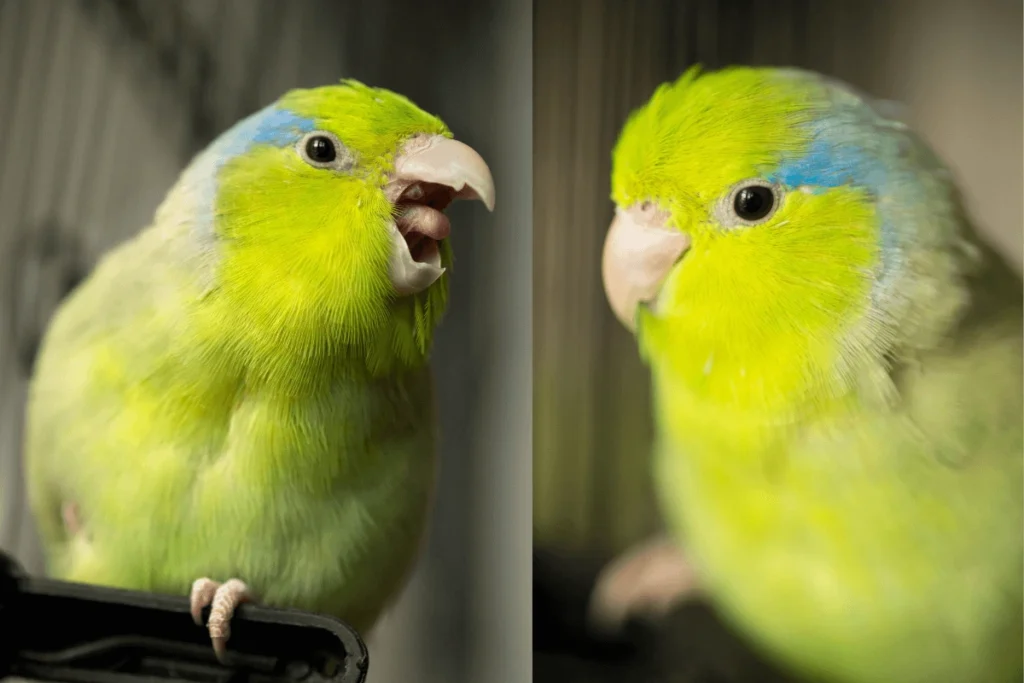
Parrotlets bite for several reasons:
- Fear or Insecurity – A Cobalt Parrotlet that hasn’t been properly tamed may bite as a defensive reaction. If it feels threatened by sudden movements, unfamiliar hands, or a stressful environment, it may use biting to protect itself.
- Territorial Instincts – Some parrotlets become possessive over their cage, toys, or food. If a Cobalt Parrotlet sees a hand as an intruder in its space, it may bite to defend its territory.
- Overstimulation or Excitement – A playful Cobalt Parrotlet may get carried away during handling or playtime, leading to nips that start as exploration but turn into harder bites.
- Lack of Boundaries – If biting hasn’t been discouraged early on, a Cobalt Parrotlet may see it as an acceptable way to communicate frustration, excitement, or a desire for attention.
Effective Parrotlet Bite Training Techniques
Stopping biting requires patience and consistency. A Cobalt Parrotlet won’t stop overnight, but with the right approach, it can learn that biting isn’t acceptable behavior.
- Stay Calm and Don’t React Harshly
When a Cobalt Parrotlet bites, avoid pulling your hand away quickly or yelling. A sudden reaction can startle the bird and unintentionally reinforce the biting habit. Instead, stay still and use a firm but gentle response. - Use the “Earthquake” Technique
If your Cobalt Parrotlet bites your finger, slightly wobble your hand to create an unsteady surface. This makes biting uncomfortable for the bird without hurting it. The goal is to discourage biting while reinforcing that stepping up or perching calmly is a better choice. - Offer an Alternative Behavior
When a Cobalt Parrotlet starts to show signs of nipping, redirect its attention with a toy or treat. Teaching your bird that chewing on a safe object is acceptable while biting a hand is not will help shape better habits. - Use Positive Reinforcement
Instead of punishing a Cobalt Parrotlet for biting, reward good behavior. If your bird remains calm while being handled, offer a small treat or gentle praise. Consistently reinforcing non-biting behavior will encourage trust and cooperation. - Practice Step-Up Training
Teaching and reinforcing the step-up command helps redirect a Cobalt Parrotlet’s energy into a structured behavior. If a bird knows that stepping up earns a reward, it’s less likely to bite when being handled.
How to Reinforce Good Behavior While Discouraging Biting
Preventing biting isn’t just about stopping negative behavior—it’s about encouraging positive actions. A Cobalt Parrotlet that feels secure, engaged, and properly socialized is far less likely to bite.
- Reward Gentle Beak Exploration – If your Cobalt Parrotlet gently nibbles without applying pressure, offer praise or a small treat. This teaches the bird that soft beak interaction is acceptable, but hard biting is not.
- Give Your Bird Space When Needed – If a Cobalt Parrotlet appears agitated or defensive, don’t force interaction. Allow it to calm down before attempting handling again.
- Encourage Playtime to Burn Energy – Sometimes, a Cobalt Parrotlet bites simply because it has excess energy. Offering plenty of parrotlet-safe toys, interactive play, and out-of-cage time can prevent frustration-based biting.
- Maintain a Consistent Routine – Birds thrive on routine. Training and handling your Cobalt Parrotlet at the same time each day will help it feel secure, making it less likely to lash out.
Signs of Aggression vs. Playfulness in Cobalt Parrotlet Behavior
Not all nipping is aggressive. A Cobalt Parrotlet may bite playfully while exploring its environment, but it’s important to recognize when biting crosses the line into aggressive behavior.
Playful Behavior:
-Light nibbling without pressure
-Beak “tasting” while interacting
-Fluffing up feathers and bobbing head in excitement
-Gentle nipping that stops with redirection
Aggressive Behavior:
-Quick, hard bites meant to push away a hand
-Lunging at fingers or showing defensive posture
-Flattened feathers and pinning eyes (a sign of irritation)
-Repeated biting with no response to training cues
Recognizing these differences helps owners respond appropriately. If a Cobalt Parrotlet is playing, you can continue interacting while guiding its behavior. If aggression is present, it’s best to pause, reassess the situation, and adjust training methods.
By using patience, positive reinforcement, and the right training techniques, you can help your Cobalt Parrotlet develop better habits. Over time, biting will decrease, and your bird will become more trusting and affectionate.
Enriching Your Parrotlet’s Environment with the Right Toys and Cage Setup
Must-Have Parrotlet-Safe Toys to Encourage Mental Stimulation
A Cobalt Parrotlet is an intelligent and highly active bird that thrives on mental stimulation. Without proper enrichment, it may develop unwanted behaviors such as excessive screaming, feather plucking, or aggression. The right toys keep your bird entertained, engaged, and mentally sharp.
Best Toys for a Cobalt Parrotlet:
- Foraging Toys – These toys encourage a Cobalt Parrotlet to work for treats, mimicking natural foraging behavior. Puzzle feeders, treat-dispensing balls, and shredded paper boxes keep their minds busy.
- Chew Toys – Parrotlets love to chew! Safe options like balsa wood, vine balls, and natural seagrass mats satisfy their need to gnaw while protecting furniture and cage bars from damage.
- Swing and Climbing Toys – A Cobalt Parrotlet enjoys movement, so rope perches, ladders, and swings provide exercise while preventing boredom.
- Shreddable and Destructible Toys – Paper-based toys, bird-safe cardboard, and palm leaf shredders let your Cobalt Parrotlet tear and explore, offering a natural outlet for energy.
Toy Safety Tips:
- Avoid toys with small metal parts, loose threads, or painted surfaces that could be toxic.
- Rotate toys regularly to keep things fresh and exciting.
- Supervise new toys at first to ensure they’re safe for your Cobalt Parrotlet.
How to Set Up the Perfect Cobalt Parrotlet Cage for Comfort and Security
A Cobalt Parrotlet spends a significant amount of time in its cage, so setting up the perfect environment is crucial for its well-being. A well-designed cage provides safety, stimulation, and a sense of security.
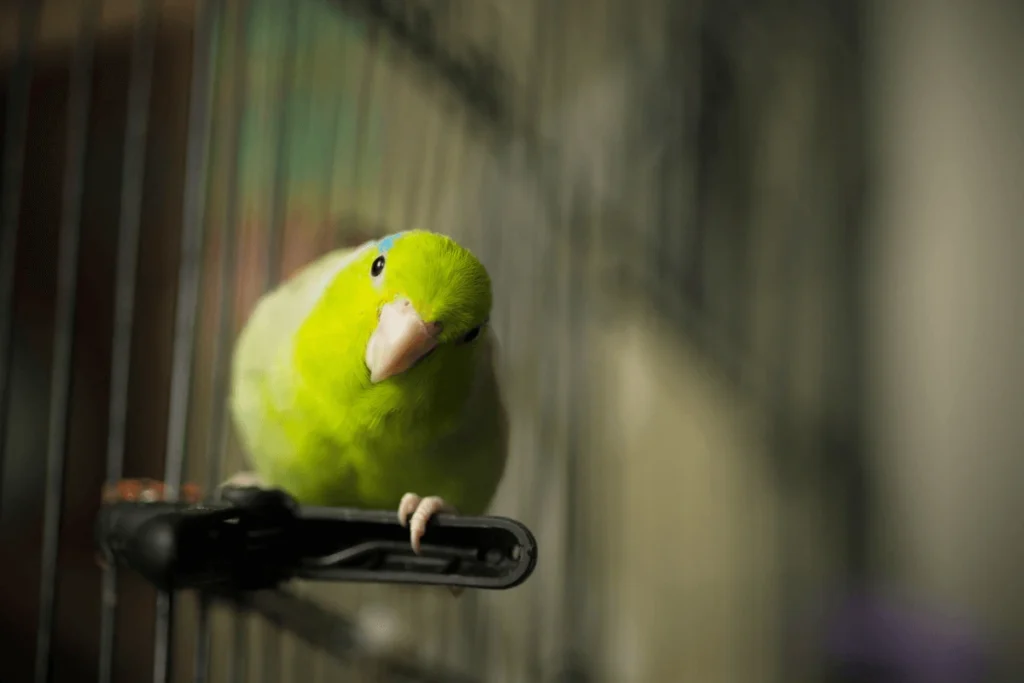
Key Factors in Cage Setup:
- Size Matters – A Cobalt Parrotlet needs space to move, stretch, and explore. A cage should be at least 18x18x24 inches, but bigger is always better. Horizontal space is especially important for flight.
- Bar Spacing – The spacing should be no wider than ½ inch to prevent escape or injury. A parrotlet can squeeze through surprisingly small gaps.
- Perches of Different Textures – Natural wood perches, rope perches, and rough-textured perches help keep feet healthy and prevent pressure sores.
- Sleeping Area – A cozy corner with a snuggle hut or fleece-covered perch gives a Cobalt Parrotlet a sense of security at night.
- Easy Access to Food and Water – Place dishes in areas where the bird can comfortably reach them, but not directly under perches to avoid contamination.
A well-organized cage provides comfort while allowing your Cobalt Parrotlet to explore, play, and rest peacefully.
Rotating Toys to Prevent Boredom and Feather Plucking
Even the best toys lose their appeal if they stay in the cage for too long. A Cobalt Parrotlet needs variety to stay engaged and mentally stimulated. Regularly swapping toys can prevent boredom-related issues like feather plucking, aggression, and destructive behavior.
How to Rotate Toys Effectively:
- Change toys every 3-4 days – Keep your Cobalt Parrotlet curious by introducing “new” toys from a hidden stash.
- Use different types of toys – Alternate between foraging, shredding, climbing, and interactive toys to keep playtime dynamic.
- Observe Preferences – If a Cobalt Parrotlet has a favorite toy, keep it in rotation more frequently but introduce variations (e.g., different colors or materials).
- DIY Toy Ideas – Simple household items like crumpled paper, popsicle sticks, and bird-safe beads make excellent DIY enrichment toys.
By keeping the cage environment fresh and exciting, you encourage healthy mental stimulation while preventing destructive habits like feather plucking.
Choosing the Right Bird Cage Accessories for a Happy Pet
A Cobalt Parrotlet needs more than just toys and perches to feel comfortable in its cage. The right accessories enhance its quality of life and make care easier for you as an owner.
Essential Cage Accessories:
- Bird Bath – Parrotlets love to bathe! A shallow water dish or a clip-on bird bath helps keep feathers clean and skin healthy.
- Food and Water Dishes – Choose sturdy, easy-to-clean bowls that attach securely to prevent spills. Stainless steel or ceramic dishes are best for hygiene.
- Cage Liners – Use newspaper or bird-safe cage liners to make cleaning easier while keeping the cage environment fresh.
- Night Cover or Sleep Tent – A breathable cage cover or a cozy fleece hideout can help your Cobalt Parrotlet feel secure during sleep.
- Calcium and Mineral Blocks – These accessories provide essential nutrients and help maintain a strong beak.
With the right accessories, a Cobalt Parrotlet will feel comfortable, safe, and well-cared for. Investing in a proper setup ensures a happy and healthy pet while making daily care more convenient for you.
By providing engaging toys, a well-organized cage, and the right accessories, you create a stimulating and enriching environment that supports your Cobalt Parrotlet’s mental and physical well-being.
Diet and Health: The Secret to a Happy and Well-Trained Parrotlet
Essential Components of a Balanced Diet (Fruits, Seeds, Pellets)
A well-balanced diet is crucial for keeping your parrotlet healthy, active, and engaged. Proper nutrition supports overall well-being, vibrant feathers, and a strong immune system while also influencing behavior and energy levels.
Key Components of a Healthy Diet:
- High-Quality Pellets (60-70%)
- Formulated pellets provide essential vitamins and minerals, ensuring balanced nutrition.
- Choose natural, dye-free pellets designed for small parrots.
- Fresh Vegetables and Fruits (20-25%)
- Leafy greens (kale, spinach, dandelion) are packed with nutrients.
- Bell peppers, carrots, and broccoli add variety to their diet.
- Fruits like apples, berries, and papaya make great occasional treats but should be fed in moderation.
- Seeds and Nuts (5-10%)
- Seeds should be a treat rather than a staple to prevent obesity.
- Healthy choices include flaxseeds, chia seeds, and small portions of almonds or walnuts.
- Cooked Grains and Legumes (Optional, But Beneficial)
- Quinoa, brown rice, and lentils provide extra protein and variety.
- Fresh Water Daily
- Change water daily to ensure cleanliness and prevent contamination.
Foods to Avoid:
- Avocado, chocolate, caffeine, onions, garlic, and anything salty or sugary can be toxic.
- A seed-only diet lacks essential nutrients and can lead to health issues.
Providing a nutrient-rich, varied diet helps maintain energy levels, prevent deficiencies, and support a long, healthy life.
The Role of Nutrition in Maintaining Good Behavior and Training Success
Diet plays a major role in a bird’s behavior. Poor nutrition can lead to irritability, hyperactivity, or aggression, making training more challenging. A well-fed parrotlet is more focused, calmer, and easier to work with.
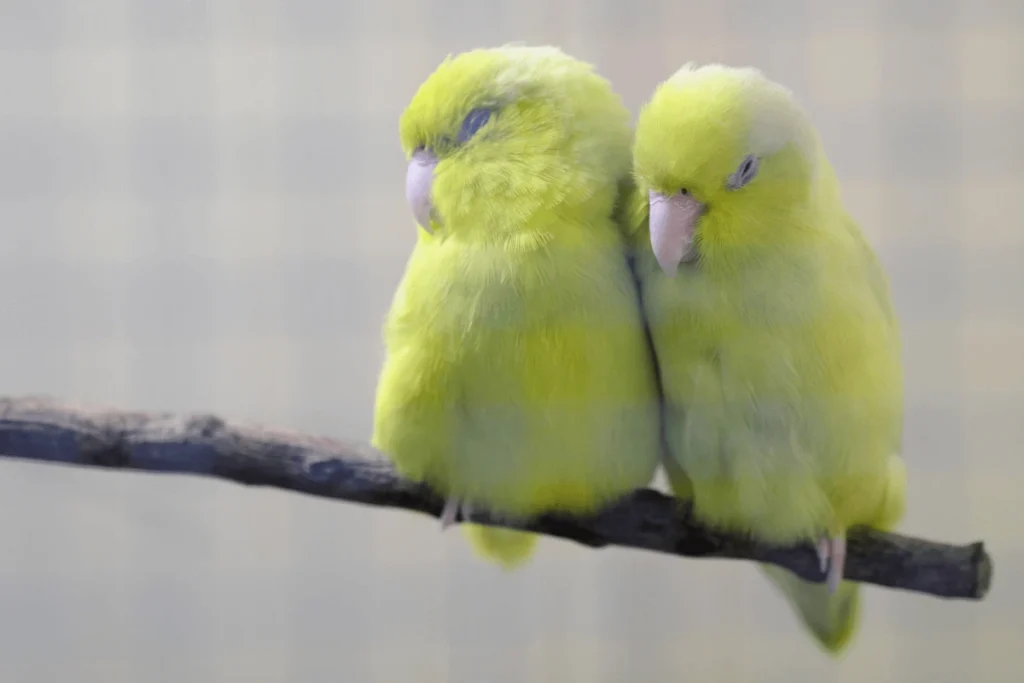
How Diet Affects Behavior:
- Balanced Energy Levels – A diet high in fatty seeds or sugary fruits can cause mood swings. Pellets and fresh vegetables provide steady energy.
- Reduced Aggression – Nutritional deficiencies, especially in Vitamin A and calcium, can lead to irritability. A complete diet helps stabilize mood.
- Improved Focus for Training – Birds respond better to training when they have steady energy. Offering small, healthy treats like millet as a reward keeps them motivated without overfeeding.
A proper diet creates a stable foundation for positive behavior and successful training sessions.
Importance of Regular Checkups with an Avian Veterinarian
Routine veterinary care is essential for long-term health. Since birds instinctively hide signs of illness, regular checkups help detect potential problems before they become serious.
Benefits of Regular Vet Visits:
- Early Disease Detection – Birds can develop illnesses that show few symptoms until they reach an advanced stage. A vet can identify issues early.
- Diet and Health Guidance – A professional can assess weight, feather condition, and overall wellness, recommending dietary adjustments if needed.
- Beak, Nail, and Feather Care – Overgrown nails or beaks can interfere with eating and perching. Regular trims help prevent discomfort.
- Preventative Care – Routine exams, bloodwork, and parasite screenings help keep your pet in peak condition.
How Often Should They See a Vet?
- Annual Checkups – A yearly visit helps monitor overall health.
- Emergency Visits – Sudden behavioral or physical changes, such as lethargy or loss of appetite, require immediate attention.
Regular vet visits ensure long-term health and help prevent avoidable medical issues.
How to Spot Early Signs of Health Issues That May Affect Behavior
Birds often hide signs of illness, making it important to monitor subtle changes in behavior, appetite, or activity levels. Recognizing early symptoms can prevent more serious health problems.
Common Warning Signs:
- Sudden Aggression or Lethargy – A normally social bird that becomes withdrawn or irritable may not be feeling well.
- Fluffed-Up Feathers for Long Periods – If a bird stays puffed up and inactive, it may be experiencing discomfort or illness.
- Loss of Appetite or Weight – Refusing food or losing weight rapidly can indicate digestive or metabolic problems.
- Changes in Droppings – Abnormal color, consistency, or odor in waste can signal liver, kidney, or digestive issues.
- Excessive Sneezing or Labored Breathing – Respiratory infections require immediate veterinary attention.
- Feather Plucking or Bald Spots – While stress and boredom can lead to plucking, underlying medical conditions should also be ruled out.
What to Do If You Notice Health Issues:
- Monitor any changes in eating, sleeping, or activity levels.
- If housed with other birds, isolate the sick one to prevent potential spread.
- Contact a vet as soon as possible to address any concerns.
By staying proactive about health and diet, you can help ensure a happy, well-adjusted bird with fewer behavioral issues.
Conclusion
Creating a happy, well-adjusted parrotlet takes time, patience, and the right approach. By focusing on early hand-taming, consistent training, and positive reinforcement, you can build a strong bond based on trust. Teaching essential commands like “step-up” not only improves obedience but also strengthens communication, making daily interactions more enjoyable.
Understanding natural behaviors, such as biting tendencies, helps prevent common issues before they escalate. Instead of punishing unwanted actions, redirecting behavior and rewarding good habits lead to better results. A well-trained bird feels secure and confident, reducing stress for both of you.
Providing an enriching environment plays a huge role in keeping your pet mentally and physically healthy. A thoughtfully designed cage setup, along with a rotation of stimulating toys, prevents boredom and destructive habits like feather plucking. Encouraging natural play and curiosity also fosters engagement, making training sessions smoother and more effective.
Nutrition is just as important as training and mental stimulation. A balanced diet that includes fresh vegetables, fruits, pellets, and occasional treats supports overall health and influences mood and behavior. Regular vet checkups ensure any potential health issues are caught early, preventing problems that could impact your pet’s well-being.
By combining proper training, enrichment, and a healthy diet, you create the best possible environment for a thriving, affectionate companion. The effort you put into bonding and understanding your parrotlet will be rewarded with years of companionship, playful energy, and mutual trust.
Read About The Adorable Tepui Parrotlet in this Article.
Discover the Top 10 Small Parrots for New Owners Here.
Discover The Purple Parrot Birds From Here.
Read About Other Pets and breeds From HERE!
Find Out the Best stuff for your Pet On Pet MD Official.
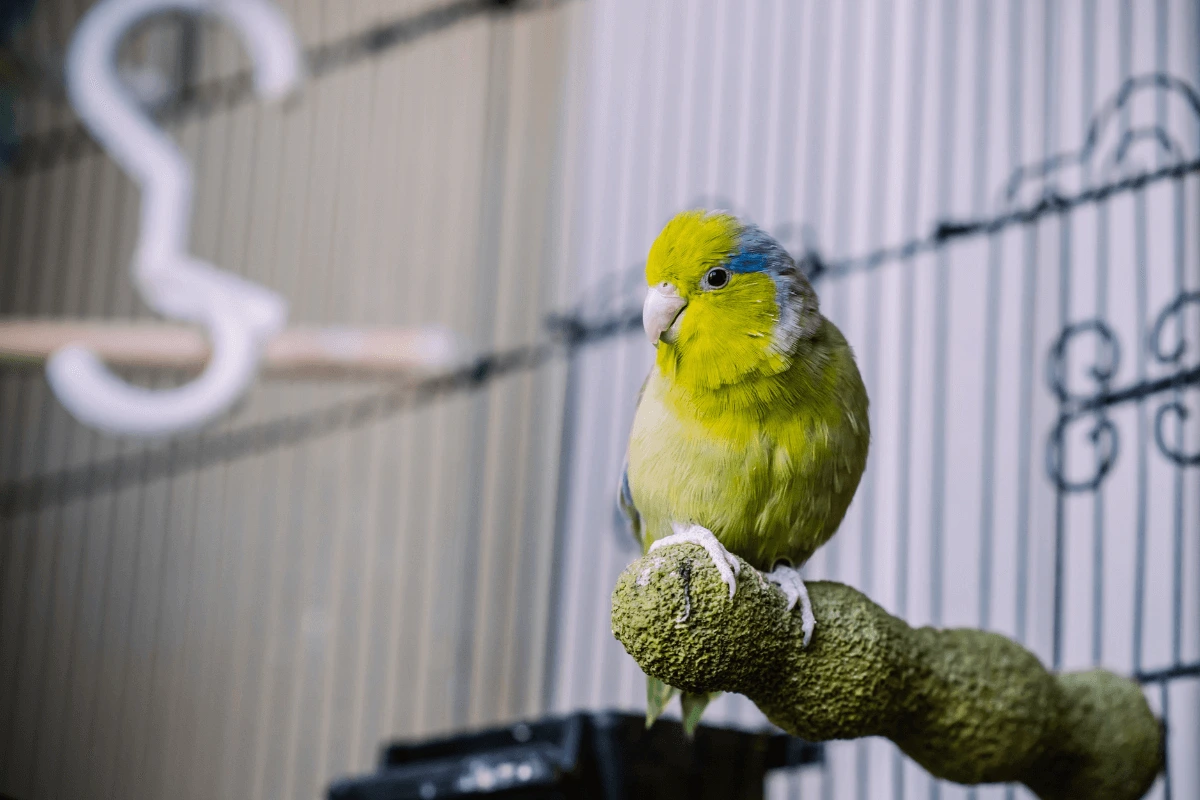
1 thought on “Top 5 Cobalt Parrotlet Secrets: Training Tips for a Happy Pet”
Comments are closed.